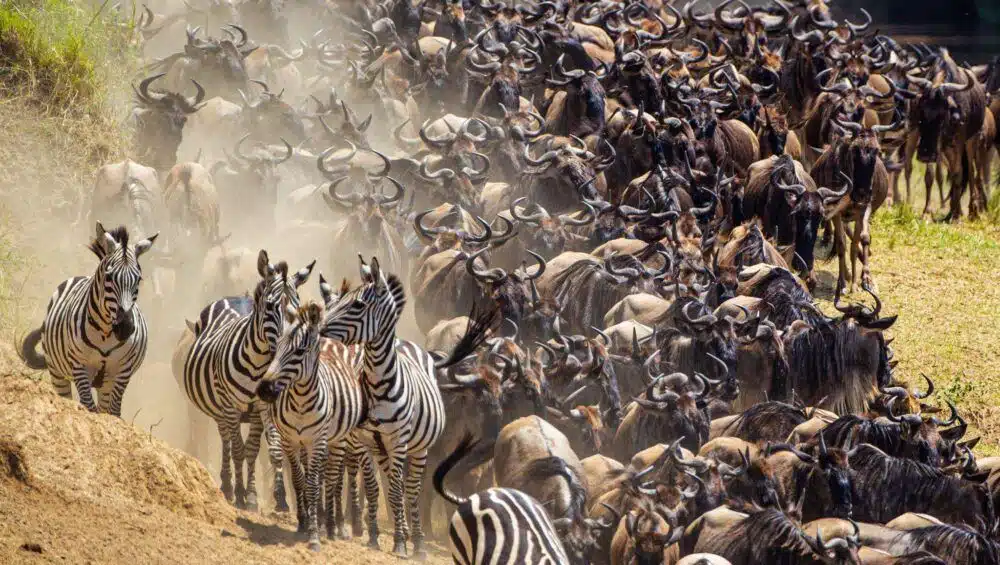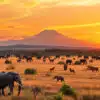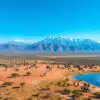Introduction to the Great Migration Calving Season
Imagine this: You’re on a vast African plain, and around you, thousands of wildebeest are scattered as far as the eye can see. It’s like stepping into a wildlife documentary, but it’s real and happening right in front of you. This is the Great Migration, one of nature’s most spectacular events, and you’re here for its most magical phase – the calving season.
So, what’s all the fuss about the calving season? Well, let me paint the picture for you. Every year, over a million wildebeest, along with hundreds of thousands of zebras and gazelles, undertake a circular journey of nearly 2,000 miles in search of greener pastures. As breathtaking as the sheer scale of this migration is, the calving season adds a whole new layer of wonder. During this period, which typically occurs between January and March, around 8,000 wildebeest calves are born each day. Yes, you heard that right – each day! Can you imagine the sight of thousands of wobbly-legged newborns taking their first steps? It’s a wildlife extravaganza that offers a front-row seat to the circle of life.
Now, you might be wondering, When is the best time to pack my bags and witness this marvel? Well, timing is everything. To see the calving season in all its glory, the sweet spot is usually from late January to early March. It’s when the southern Serengeti, along with the Ngorongoro Conservation Area, becomes the stage for this breathtaking event. The lush, green landscapes, combined with the abundance of newborns, attract predators, offering unmatched game-viewing opportunities. Nature’s drama unfolds before your eyes – raw, unfiltered, and incredibly poignant.
If your curiosity is piqued and you’re ready to embark on this adventure, stick with me. I’ve rounded up 10 essential tips to help you make the most of the Great Migration calving season, ensuring your experience is nothing short of extraordinary. Buckle up, because this journey promises to be as thrilling as the event itself!
Introduction to the Great Migration Calving Season
Overview of the Great Migration
Have you ever dreamt of encountering one of nature’s most dramatic spectacles? Well, let me tell you about the Great Migration. Each year, millions of wildebeest, zebras, and gazelles embark on an epic journey across the plains of East Africa. It’s a 1,200-mile round trip that is nothing short of awe-inspiring. Trust me, seeing this with your own eyes will leave you feeling like you’ve walked straight into a National Geographic documentary.
Now, the Great Migration isn’t just a mindless wander across the savannah—oh no, it’s a highly strategic and intricate travel plan designed by Mother Nature herself. The animals move in a cycle, following the rains and the resulting growth of new grass. Their route stretches from the Serengeti in Tanzania to the Maasai Mara in Kenya. But what makes this journey even more breathtaking is the calving season.
Significance of the Calving Season
Why all the fuss about calving season, you ask? Well, this is the period when over 500,000 wildebeest calves are born. Just imagine thousands of babies taking their first steps, closely followed by their mothers and constantly watched by hungry predators. There’s a certain raw beauty to it—yes, even though it involves some high-stakes drama between life and death.
It’s not just about the sheer number of new lives; it’s about the unique behaviors and interactions you get to witness. Have you ever seen a lioness on the hunt or a newborn calf wobbling on its legs for the first time? The calving season offers you a front-row seat to these unforgettable moments.
Best Time to Witness the Event
So, when should you pack your bags and book that flight? The calving season typically takes place from late January to early March. The specific timing can vary slightly each year based on rainfall patterns, so keeping an eye on weather updates can be useful.
In my experience, the best time to catch this spectacle is around mid-February. That’s when most of the calves are born, and the predator activity is at its peak. But don’t just take my word for it—getting expert advice can also fine-tune your plans. Tour operators specializing in the Great Migration have a good grasp on the timing, so don’t hesitate to pick their brains.
Tip #1: Timing Your Visit
Peak Months for the Calving Season
So, you’re stoked about witnessing the sheer marvel of the Great Migration Calving Season, right? Timing is everything. The peak for the calving season is typically from late January to early March. This period is transformative; the South Serengeti turns into a playground for thousands of newborn wildebeest, zebras, and gazelles.
Imagine standing on the vast plains, watching new life take its first steps. It’s like nature’s version of a grand debutante ball. One minute, you’re seeing a mother wildebeest nudge her newborn to stand up, and the next, you might witness a dramatic chase as predators also consider this timeframe ideal for hunting. Fascinating, isn’t it?
Weather Conditions and Their Impact
But hold on before you pack your bags. Let’s chat about weather conditions. The calving season coincides with the shorter rains in the region, which aren’t as formidable as the long rains that come later in the year. The occasional showers can actually cool things down a bit and keep the dust in check, making your safari experience more pleasant.
However, weather can be as unpredictable as getting a toddler to eat their veggies. In a year with heavier rains, the landscape can turn lush and green, creating a picturesque setting, but also, potentially, muddy roads. You might spend a bit of time waiting for your safari vehicle to emerge from a particularly sticky spot. But hey, that’s part of the adventure, right?
Booking Early for Best Opportunities
Now, let’s talk logistics. Booking early is crucial. Believe me, everyone and their grandma wants to witness the Great Migration Calving Season. As soon as you’ve decided to embark on this journey, start making inquiries. Safari lodges and camps often get booked up well in advance, especially the ones situated in prime locations.
Here’s a personal anecdote: I once decided on a whim to go see the calving season. Guess what? I ended up in a lodge miles away from the action. The early birds had indeed gotten the worms—or rather, the best lodges. So, to save yourself from such disappointment, plan ahead. Booking your safari six to twelve months in advance can give you a higher chance of gaining those coveted spots and adding a feather to your safari cap.
Timing your visit to the Great Migration Calving Season doesn’t just heighten your experience; it guarantees you a front-row seat to one of nature’s most extraordinary spectacles. So mark those calendars and start planning. The wildebeests are waiting!
Tip #3: Opt for Mobile Camps
Advantages of Mobile Camps Over Permanent Lodges
Picture this: You’re sipping your morning coffee, the sun is just creeping over the horizon, and you hear the distant yet unmistakable sound of wildebeest hooves. Now, imagine this scenario from the comfort of a mobile camp, right in the heart of the action. One of the main advantages of mobile camps is their flexibility. Unlike permanent lodges that stay fixed in one location, mobile camps move with the wildlife. This means you are always in the best possible spot to witness the Great Migration calving season.
I once stayed at a permanent lodge, and while it was gorgeous and comfortable, we often found ourselves driving long distances to catch sight of the herds. Then, on a different trip, I opted for a mobile camp. The difference was night and day. Being right there amongst the wildlife heightened every experience. Plus, who wouldn’t want to fall asleep to the sounds of nature all around?
Proximity to Wildlife Action
When it comes to experiencing the Great Migration, proximity is key. Mobile camps can set up right where the action is hottest, moving to follow the herds and ensuring that you’re not missing out on any of the drama. You’re not just observing from a distance; you’re practically living amongst the animals. Imagine those spots you see on documentaries where the action is just a stone’s throw away—that’s what mobile camps offer.
I remember one evening at a mobile camp in the Ndutu region of the Ngorongoro Conservation Area. As we were having dinner, a herd of wildebeests started to gather nearby. We spent the evening watching them interact, from a safe yet intimate distance. Moments like these are what make mobile camps unbeatable.
Suggested Mobile Camp Options in Key Regions
If you’re now sold on the idea of opting for a mobile camp (and who could blame you?), you might be wondering where to start. Here are a few top-notch mobile camps to consider:
1. &Beyond Serengeti Under Canvas
Known for their luxurious yet eco-friendly approach, &Beyond Serengeti Under Canvas offers beautifully furnished tents that move along with the migration paths. Not only do you get an incredibly close-up experience, but the knowledgeable guides and the camp’s commitment to sustainability make it a standout option.
2. Elewana Serengeti Pioneer Camp
This camp provides a blend of classic safari charm and modern comfort. Located in the southern Serengeti during the calving season, it offers fantastic access to the action while ensuring you have all the amenities you need for a comfortable stay.
3. Serengeti Safari Camp by Nomad Tanzania
Nomad Tanzania’s mobile camp is practically synonymous with the Great Migration. They set up in prime locations throughout the year, ensuring you’re perfectly positioned to see the calving season up close. Their guides are incredibly knowledgeable, adding another layer to your experience.
4. Ubuntu Migration Camp
This intimate, eco-friendly camp moves three times a year to follow the migration. During the calving season, they settle in the southern Serengeti, ensuring you’re right where the action is. With just eight tents, it offers a more personalized experience, perfect for those looking to truly immerse themselves in the wild.
Deciding to go with a mobile camp could very well be the best choice you make for your Great Migration adventure. Not only will you be closer to the action, but you’ll also have stories and memories that will last a lifetime.
Tip #3: Opt for Mobile Camps
Advantages of Mobile Camps Over Permanent Lodges
Imagine waking up to the sounds of nature, the calls of wildebeest echoing through the crisp morning air. Now contrast that to the muffled experience from a permanent lodge, further from the action. Mobile camps bring you right to the heart of the Great Migration, offering an unmatched, immersive experience. They move with the herds, ensuring you’re always in the thick of the action instead of miles away, driving for hours to catch a glimpse of the spectacle. Isn’t that what you’d want from your safari adventure?
Proximity to Wildlife Action
The real beauty of mobile camps is their ability to set up in strategic locations, often near waterholes or along key migration paths. Last year, during my own adventure, our camp was set up near a river crossing. We’d barely finished breakfast when we saw thousands of wildebeest making their daring plunge into the water. No need for a lengthy drive; it was right there! Imagine lounging in a hammock, sipping your coffee, and having nature’s greatest show play out right in front of you. It’s magical!
Suggested Mobile Camp Options in Key Regions
The Serengeti and Maasai Mara are prime locations for mobile camps. A few favorites that come to mind include:
- Nomad Tanzania: They offer highly flexible options, moving across the Serengeti to follow the migration’s path. Their camps are cozy, with just the right amount of luxury without losing that wild edge.
- Asilia’s Olakira Camp: This camp transforms with the seasons, positioning itself strategically to catch the herds. They even have netted tents to lay back and stargaze – talk about camping with style!
- Alex Walker’s Serian Mobile Migration Camp: Nestled in the Mara, this camp offers an authentic bush experience with top-notch guides who seem to have a sixth sense for finding wildlife action.
Choosing a mobile camp not only brings you closer to nature but adds an element of adventure and spontaneity to your journey. These camps are often eco-friendly, causing minimal disruption to the environment, and they operate under strict regulations, ensuring an ethical wildlife experience. So, are you ready to dive right into the heart of the Great Migration with a mobile camp?
Conclusion
So, there you have it – your ultimate guide to making the most out of the Great Migration calving season. The magical dance of life and survival that unfolds in the vast plains of East Africa is something everyone should experience at least once in their lifetime. From timing your visit just right to choosing the perfect safari operator, each tip is engineered to give you the best seat in the house, or should I say, savannah?
Imagine standing in the golden grasslands, watching a newborn wildebeest take its first wobbly steps, surrounded by the rich tapestry of African wildlife. There’s truly nothing like it. Of course, it doesn’t hurt to have an outstanding guide by your side to narrate the stories that aren’t visible to the naked eye. And staying in those mobile camps, close to the action, ensures you don’t miss a heartbeat of this incredible phenomenon.
Remember, the magic of the Great Migration lies in its unpredictability and raw beauty. Being prepared as much as possible lets you focus on soaking up these once-in-a-lifetime moments. So, pack your bags, grab your camera, and get ready for an adventure that will stay with you forever. Who knows? Maybe next time we’ll bump into each other under the African sky, sharing stories of our unforgettable memories.
Until then, happy safari planning!





